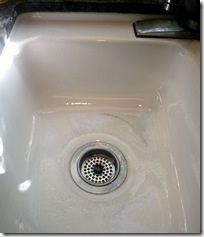I’m the fellow that leaped off the couch signaling a “wave off” … frantically gesticulating while your diatribe continues unabated …
“Yea, it’s great I showed the shop some of my flies and they want me to tie for them it’s great I get a big discount on all my stuff 40% off on rods and waders and tippet and books and my wife can’t say sheeet!”
“Yea, but …”
“…and the thing that is really cool is I’m tying these twenty dozen wooly worms and they’re fast as hell and I’m making all kinds of money and it’s going to be great ‘cause the IRS don’t know sheeet!”
“Yea, BUT…”
“ …don’t harsh my buzz ‘cause I’m a machine cranking these bad boys out they wanted five dozen peacock and five dozen brown and five dozen purple and five dozen grey so I’m unleashing some serious bucks and you’re trying to rain on my parade ‘cause they didn’t ask you and you can’t tie sheeet!”
“Yea, that was just the first order Meatloaf, new talent always gets training wheel flies to draw them in, and now your new boss is contemplating which miniscule hell he’s going to unleash on your second order.
In fact, I got a dollar that says he wants #16 and #18 Henryville Specials, with the little spray of lemon wood duck between the quill wings, better yet I’ll go lobster dinner if I’m wrong.”
A week later I get the pitiful-yet-defiant voice on the other end of the phone, “I finished that order for wooly worms.”
“Yea, and ….”
“I picked out the Sage rod I’m getting …”
“ … and …”
“ … and the prick wants me to tie 100 dozen Quill Wing Royal Coachmen in size 18 and another hunert dozen in 20.”
“ … and which Sizzler was you taking me to?”
My first order was from a family friend, fifty cents apiece for two dozen #14 Adams. I was about 15 at the time and that was all the money in the known world.
Ditto for the second, third, and fourth orders. Brindle Bugs in size 6 & 8 – only they had to look exactly like the specimen provided; thirty years mashed in a fly box, dampened and dried countless times, bleached by sunlight, then handed over with complete reverence.
Even at that tender age I knew he meant it.
It was bad enough the solution involved lining garbage cans until Poppa offered to drive me to Mecca. That was Creative Sports Enterprises, Andre Puyans, and the giant crate of fifty cent India capes, the only establishment that offered hope of finding a Rhode Island Red that had been pawed over and bleached by incandescent to mimic Rhode kill.
… and the hooks were no longer made, so the hangers-on at the cash register tried to get rid of me with the standard fare, then endured my critical regard for the Mustad’s he offered before I lit him up, “limerick bend small barb, 2X long, bronzed, tapered and looped down eye, steelhead hook … these are model perfect bend and forged, what else you got?”
… even Puyans raised an eyebrow at my steely tone.
I pocketed eighteen whole dollars at the cost of nine. Two weeks of arduous labor to complete three dozen, and the proceeds were a princely sum … for the Sudan or Somalia.
I eked out a small subsidence wage pimping tiny dry flies to school children, until the American Casting Association needed 60 dozen tournament dry flies with trimmed hackle.
Months later, Ma was still sweeping the dander from yellow saddle hackle out of the living room … and I was approaching the dollar-an-hour barrier, which like the speed of sound was something mysterious, theoretical, and largely mythical.
Now that I was big enough to peer over the counter, as I pawed through smuggled Chinese capes at the local shop, mentioned that I “had vice, will travel” … and the portly gentleman manning the register figured he could run me off by demanding to see my letters of marque.
Samples. Lots of them.
… and while he pawed through Caddis and mayflies in assorted shapes, sizes and colors, confessed to an immediate need for Umpqua Specials, size 8, “bring ‘em until I say stop.”
Steelhead stuff was easy money, and as the Umpqua Special was a standard pattern and didn’t require yellow saddle, I was a budding entrepreneur.
“Gray thread? Who told you to use Gray thread for the head on an Umpqua Special?”
I was caught unawares, and while the guilty party was likely Trey Combs or AJ McClane, assisted by a grainy photograph, I realized us commercial fly tiers were not chosen for our artistic tendencies nor innate sense of fashion, commercial flies were “acne” – black heads on everything.
…until he ordered Light Cahill’s, where I heard similar, “Black Thread? Who told you …”
The Devil was always detail. Never leave the establishment without a sample, failing that, never guess, never embellish, and absent a hard sample, lock in the thread color beforehand.
I was an animal.
I started the day brushing teeth and memorizing fly patterns, and while the other kids were at lunch, rifled their desk for the brass tubes from ballpoint pens, drained the ink and made barrels for tube flies. Homework assignments were works of art, their content marginal, but the margins festooned with Trichoptera, mating Odonata and dancing mayfly nymphs for the late assignments.
My pals talked carburetors and valve timings, and I responded with metatarsals and pronotum, both parties nodding sagely at the other’s comments – entirely ignorant of their meaning, but multiple syllables being smarter than singles, whatever he’d said was surely profound.
They discovered posi-traction and I learned their interior was navy blue chenille, and how vinyl fuel line in small diameters makes a great sleeve for a salvaged ballpoint enroute to salmon greatness.
I was “Neo,” The One. The kid that answered strange phone calls from desperate anglers, from Captains of Industry, where black limo’s swooped to the curb and neatly folded brown baggies were exchanged for wads of cash, stock options, or smuggled exotics from far continents.
“Hello?”
“Can you tie a fly called a Green Highlander, and could you have three dozen 4/0’s done by Thursday?”
“Sure, you want that in traditional full dress, or low water, tube-style, hairwing, reduced, original Kelson, the Scottish or Irish variant, spey style, Dee style, on a Waddington shank, or tied on a Salmon double?”
“Shit, I don’t know, they just told me to bring those!”
“I’ll need a Dun & Bradstreet, your last two years of Income Tax returns, and the name of the river you’re going to fish – or you can smuggle an ounce of baby seal back through customs and I’ll waive the fee for the Lady Amherst and Silver Monkey hair.”
“D-d-de-Deal!”
Smuggling was part and parcel of the enterprise, as a trip to Tasmania meant you could afford the surcharge for “real” Tasmanian Devil fur, Newt eyelash, or whatever indigenous species the locals raped for their flies. Upon your return or via anonymous post you sent the plainly wrapped endangered species to a pre-arranged safe house.
Mine. Mostly.
The basement dumpster of the US Customs Office yielded a current copy of the regulations and prohibitions, and offshore vendors were thrilled to label the forbidden package, “Commercial synthetic samples, not for resale.”
Despite all those federal agencies and sniffing canines, there was only one guy at the airport that knew what sawdust in the fiber meant, only one guy that could recognize a Grey Jungle Fowl – and while the dogs pawed through the luggage from Bogota, intent on valises stuffed with white powder, Golden Bird of Paradise just looked like a drab chicken by comparison.
There weren’t any pastel tee shirts or cigar boats in my future, no gold chains – and while my pals had discarded crankshafts and blowers for girls, I was battling moths.
Safely in college, yet broke due to reinvestment of all proceeds, I memorized war movies and naked celebrities. A decade of breathing Naptha and licking arsenic off your fingers meant the daylight hours were spent in class sleeping, and the evenings were tying flies for cash.
Stuff started hurting, first your backside from all those late night cram sessions involving unsteady chairs and great gouts of deer hair, whose hook points were invisible to mashing fingers until you exerted enough for a clean through-and through. The drone of the war movie in the background while you focused on upright and divided, until the soundtrack cued you that the platoon was going to get raked by gunfire, or the point man dismembered …
Ditto for celebrity skin, craning forward to ensure the post on the parachute was just tall enough, only to glance up for the obligatory disrobing scene, followed by three turns of Ginger and a whip finish.
The fly received that – Ginger got what broadcast TV allowed, then faded to commercial.
By then I was “Little Dry Fly” – a rare find for a shop, as the less talented were assigned duties and the Indian names corresponding; the “Zug Bug Guy” or “Balding Hare’s Ear.” None of us were referred to by name or with any real human courtesy – we were commercial fly tiers with clever sounding Indian names, distinguished by our always being late with the order, always short, and when un-chaperoned – always elbow deep in your Metz necks.
We were calloused, hardcore, and harder to find when the order was due …
… the only thing harder than us was getting paid, as every proprietor had visions of retiring to a fly shop and little knowledge of how to run one.
Like hired guns, we’d occasionally cross paths – often when reaching for the same tuft of marabou or grizzly neck – standing hipshot in the thread aisle talking war stories, “… he ordered 400 dozen #16’s? Dude, that’s depressing, count backwards or something so it seems like you got more done …”
Flies didn’t exist singly any longer. Your fingers had a will of their own, and only dozens counted. A bright idea for an experimental, and you’d glance down and there’d be a dozen finished.
New thread?
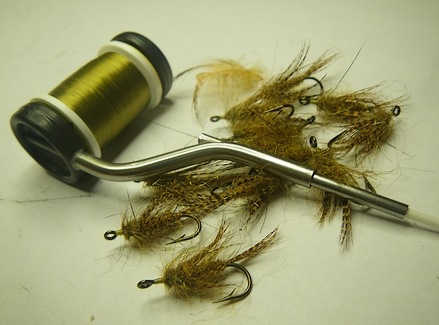
… another dozen. New dubbing color?
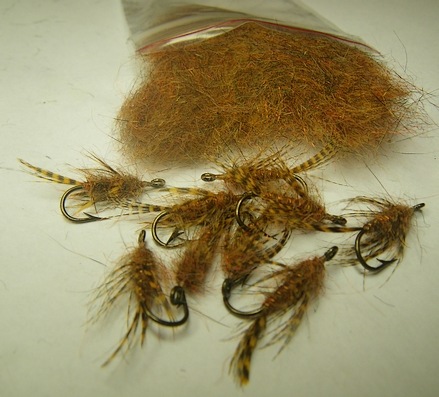
A bronze olive accident in the dye pot and … you guessed it.
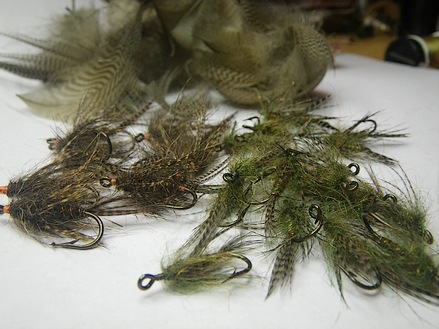
You’re at the height of your craft, mind whirling with combinations and permutations and fingers follow without conscious thought, everything looks fishy, all of them edible, only your fly box is full.
… so is the second one you carry, and the reject box you pretend to leave out for your kin to pillage, and the steelhead box, and the coffee can next to the varnish spill.
… double for the big box you bought for dubbing, and your sock drawer.
… and all those tungsten and copper beads, lead wire and cone heads – are not so much selection as death warrant, and the inevitable header cataclysmic – akin to a Polaris class sub in full alarm dive.
If you’re lucky you’ll leave an oil slick and floating debris, so the widow can toss a wreath at the spot while inviting your pals to paw through all your accumulated Precious.
One day you look back on all that misspent youth and misplaced ardor and wonder – did you ever take possession of that discounted Sage rod, or does the sumbitch still owe you …
Test. Sage rod, commercial fly tying, dubbing, steelhead, bead head, cone head, thick head, fly tying humor, fly tying blog, fly fishing, Green Highlander, baby seal, U. S. Department of Fish and Wildlife, captains of industry
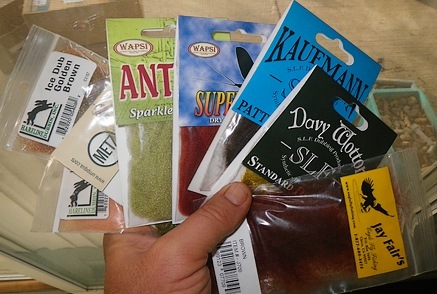

 If you’ve ever supervised others you understand how closely work resembles high school. Inkwells replaced by cubicles and communal refrigerators, pigtails a thing of the past, but the guy that dries his shoes in the microwave, or thumbs the donuts is a worthy substitute.
If you’ve ever supervised others you understand how closely work resembles high school. Inkwells replaced by cubicles and communal refrigerators, pigtails a thing of the past, but the guy that dries his shoes in the microwave, or thumbs the donuts is a worthy substitute.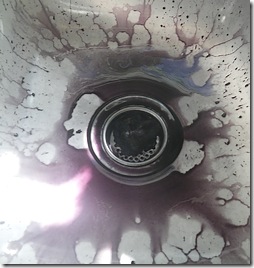 Ask anyone who’s ever fiddled with materials and you’ll see the involuntary shudder when Black is mentioned. While it enjoys status of being a must-have color among fly fishermen, getting a good permanent black will drive both professional and hobbyist to tears.
Ask anyone who’s ever fiddled with materials and you’ll see the involuntary shudder when Black is mentioned. While it enjoys status of being a must-have color among fly fishermen, getting a good permanent black will drive both professional and hobbyist to tears.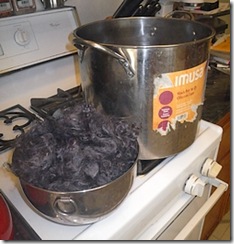
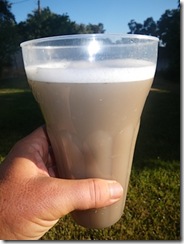 Many things can interfere with the coloring process, including natural colors (we assume the black will cover them up), dirt, grease, and oil, and the blend of dye itself. Dyes are made from rare earths and minerals, all of which activate at different times and temperatures – and if the bath doesn’t get hot enough, or is too hot – it’s possible to have a color misfire.
Many things can interfere with the coloring process, including natural colors (we assume the black will cover them up), dirt, grease, and oil, and the blend of dye itself. Dyes are made from rare earths and minerals, all of which activate at different times and temperatures – and if the bath doesn’t get hot enough, or is too hot – it’s possible to have a color misfire.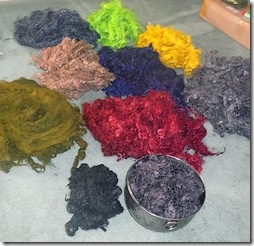 Guard hairs and stiff shiny materials are quite hard compared to loose fur or marabou. A rich deep black in Marabou may not be the same shade when dyeing a slab of Polar Bear, or similar tough material. Over dyeing a second time may fix a dark gray, and it may be enough to over dye it with a deep purple, or dark brown, rather than black.
Guard hairs and stiff shiny materials are quite hard compared to loose fur or marabou. A rich deep black in Marabou may not be the same shade when dyeing a slab of Polar Bear, or similar tough material. Over dyeing a second time may fix a dark gray, and it may be enough to over dye it with a deep purple, or dark brown, rather than black.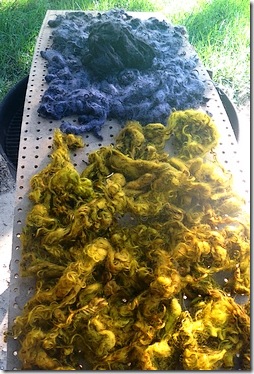



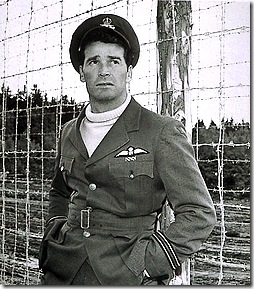 The other day I was in one of the better shops, and my non fly tying buddy asked me why the Whiting neck was $85 and the J. Fair Saddle was only $20. My explanation was overheard by the smiling fellow behind the counter and he stopped to correct me, “ there’s over 30 years of genetics in J. Fair chickens … “
The other day I was in one of the better shops, and my non fly tying buddy asked me why the Whiting neck was $85 and the J. Fair Saddle was only $20. My explanation was overheard by the smiling fellow behind the counter and he stopped to correct me, “ there’s over 30 years of genetics in J. Fair chickens … “


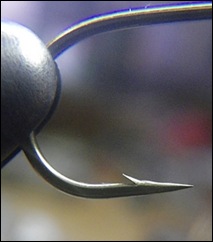
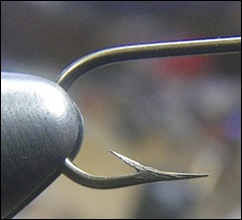
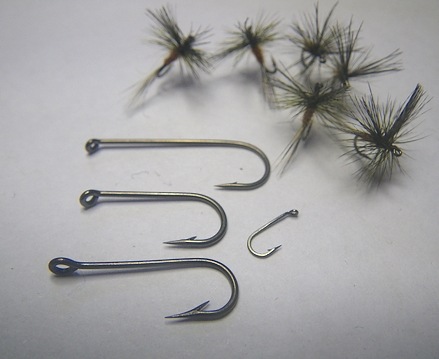
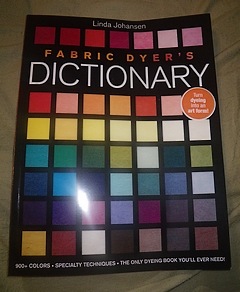 Wet dyeing is a mixture of chance and things we can bend to our will, “dry dyeing” allows us to micro-manage color and turn lemons into lemonade.
Wet dyeing is a mixture of chance and things we can bend to our will, “dry dyeing” allows us to micro-manage color and turn lemons into lemonade.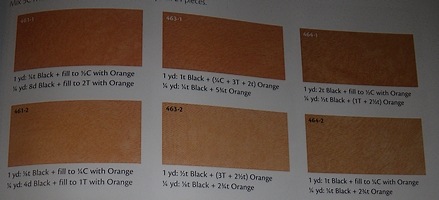
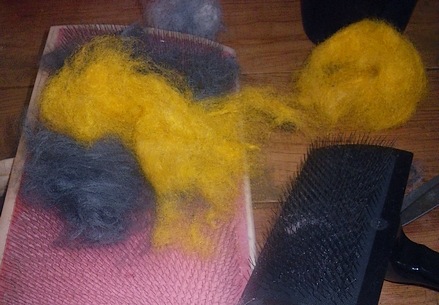
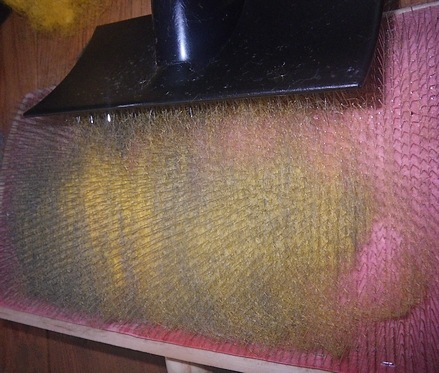
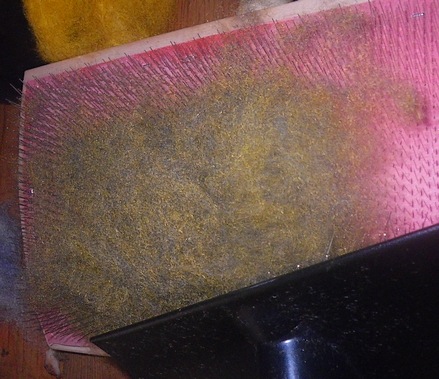

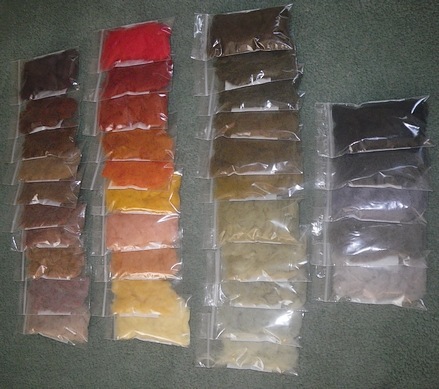
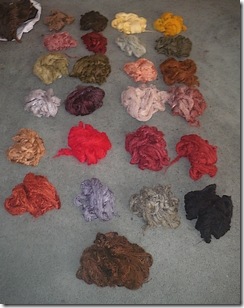 Call me a slow learner, but the aerial display of the fourth will have nothing on the fireworks tonight …
Call me a slow learner, but the aerial display of the fourth will have nothing on the fireworks tonight …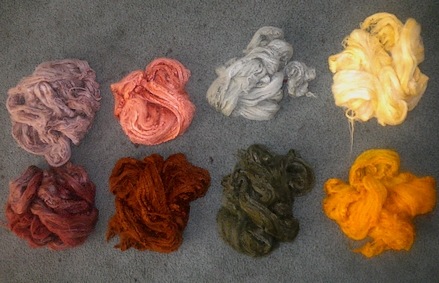
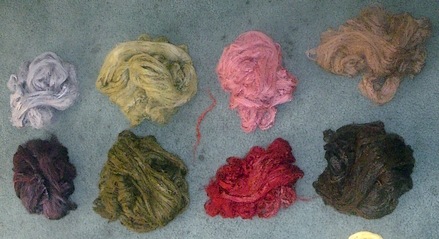
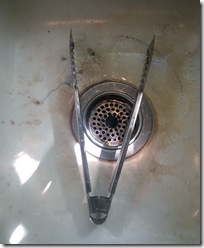 As no points are scored for being banned from the kitchen, it’s important that the how to make a complete mess is tempered with how to extricate yourself from a screaming and angry woman.
As no points are scored for being banned from the kitchen, it’s important that the how to make a complete mess is tempered with how to extricate yourself from a screaming and angry woman.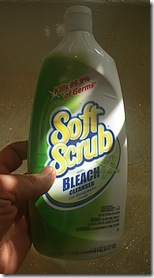 At right is the Righter of Kitchen Wrongs, cleanses fingerprints, restores the Pristine to the porcelain, and is capable of making you innocent of all imagined crimes.
At right is the Righter of Kitchen Wrongs, cleanses fingerprints, restores the Pristine to the porcelain, and is capable of making you innocent of all imagined crimes.